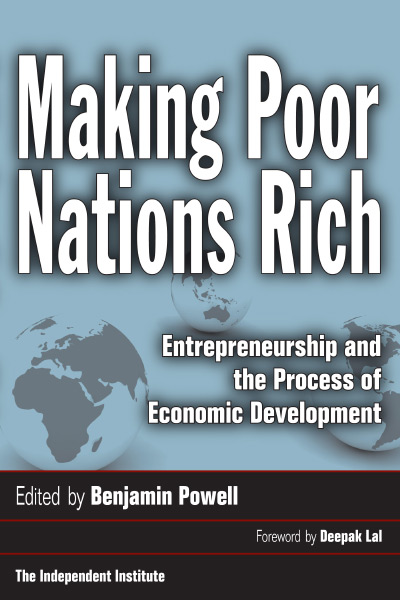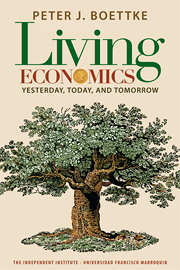| Price: | $30.95 |
| Formats |
Hardcover |
Paperback |
| Price: | $30.95 |
| Formats |
Hardcover |
Paperback |
Overview
Why do some nations become rich while others remain poor? Traditional economic theory has done little to answer this question. Now, through case studies from Asia, Africa, Latin America, and Europe, Making Poor Nations Rich argues for examining the critical role entrepreneurs, private property rights, and free trade and other economic freedoms play in economic development.
This volume begins by explaining how entrepreneurs create economic growth and why some institutional environments encourage more productive entrepreneurship than others. The book then addresses countries and regions that have failed to develop because of barriers to entrepreneurship. Finally, the authors turn to countries that have developed by reforms that protect private property and grant greater levels of economic freedom.
Making Poor Nations Rich demonstrates that pro-market reforms are essential to promoting the productive entrepreneurship that leads to economic growth, and where this institutional environment is lacking, sustained economic development will remain elusive.
Contents
1. Introduction by Ben Powell
PART I: Institutions and Entrepreneurship
2. Big Bills Left on the Sidewalk: Why Some Nations Are Rich, and Others Poor
Mancur Olson Jr.
3. Entrepreneurship and Economic Growth
Randall G. Holcombe
4. Entrepreneurship: Productive, Unproductive, and Destructive
William J. Baumol
5. Economic Freedom and Property Right: The Institutional Environment of Productive Entrepreneurship
Robert Lawson
PART II: Failures in Entrepreneurial Development
6. The African Development Conundrum
George Ayittey
7. The Case of Latin America
Alvaro Vargas Llosa
8. Entrepreneurship or Entremanureship? Digging Through Romania’s Institutional Environment for Transitional Lessons
Peter J. Boettke, Christopher J. Coyne, Peter T. Leeson
9. Sweden’s Slowdown: The Impact of Interventionism on Entrepreneurship
Dan Johansson
PART III: Reform and Success in Entrepreneurial Development
10.China’s March Toward the Market
James A. Dorn
11. India: The Elephant in the Age of Liberation
Parth J. Shah, Renuka Sane
12. Economic Freedom and Growth: The Case of the Celtic Tiger
Benjamin Powell
13. Why Have Kiwis Not Become Tigers? Reforms, Entrepreneurship, and Economic Development in New Zealand.
Frederic Sautet
14. Look, Botswana: No Hands! Why Botswana’s Government Should Let the Economy Steer Itself
Scott A. Beaulier
Detailed Summary
- Economists have often grappled with the question of how to help impoverished countries prosper, but they frequently overlook the central driver of economic growth: the entrepreneur. A close examination of entrepreneurship is especially timely, since the effectiveness of traditional development aid is increasingly being debated. Government-instituted economic reforms intended to stimulate economic growth often succeed or fail due to the extent that they help or hinder entrepreneurship. An international and historical comparison of policies and institutions that affect the productivity of entrepreneurs is invaluable for understanding how to make poor nations rich. (Introduction, ch. 1-4)
- After more than a decade of research, the empirical evidence is clear: economic freedom fosters economic growth. Countries that have climbed the Economic Freedom Index (e.g., China, India, Ireland, and Botswana) have brought more prosperity to their people, whereas countries that have reduced economic freedom (e.g., Venezuela, Zimbabwe) are poorer than they were a generation ago. (ch. 5)
- Western aid policies toward Africa have failed to reverse the continent’s economic decline. Most aid programs were crafted in Western capitals with little input from the people they were intended to benefit. Aid was used to support grandiose projects with little economic value and sometimes aid funds were looted. Rather than clean up their own houses, African leaders prefer to badger the West for more money. And the West, burdened by guilt over the iniquities of the slave trade and colonialism, obliges. (ch. 6)
- Latin America drew the wrong conclusions from the poor results of the process of reform in the 1990s. Despite some early successes (e.g., in reducing inflation, attracting foreign investment, and spurring the economy by lowering some barriers to trade), a great opportunity was missed. What really took place in those years was crony capitalism, not the decentralization of power through the desocialization of the economy, the spread of property, or the elimination of barriers to entry in all markets. (ch. 7)
- While Sweden and Romania differ in many ways, both underperform economically due to policies that impede entrepreneurship. In 1970, Sweden was the fourth richest country in the OCED; three decades later it had fallen to fourteenth. Since 1991, Romania’s economy has grown about 0.15% per year—roughly half the rate of slow-moving Kazakhstan (0.29%), and only a tiny fraction as fast as Albania (2.7%). Whereas Sweden needs to implement several reforms, such as opening access to markets, cutting taxes, and relaxing labor-market restrictions, Romania has reformed too often. The frequent changes Romania has made to its legal and regulatory environment have caused confusion and uncertainty among its would-be entrepreneurs. (ch. 8, 9)
- Although further improvements in economic freedom could be made, strides toward liberalization in China and India have probably lifted more people out of poverty than all other government anti-poverty programs combined. On a smaller scale, Ireland, New Zealand, and Botswana have also improved economic growth by making their countries more hospitable to entrepreneurship. Unfortunately, without a stronger commitment to private-property rights and economic freedom, continued improvements are precarious. (ch. 10-14)
Why do some nations become rich while others remain poor? Traditional mainstream economic growth theory has done little to answer this question—during most of the twentieth century the theory focused on models that assumed growth was a simple function of labor, capital, and technology. Through a collection of case studies from Asia and Africa to Latin America and Europe, Making Poor Nations Rich: Entrepreneurship and the Process of Economic Development emphasizes the critical role that entrepreneurs, private-property rights, and economic freedom play in economic development.
Making Poor Nations Rich begins by explaining how entrepreneurs create economic growth and why some institutional environments encourage more productive entrepreneurship than others. The volume then addresses countries and regions which have failed to develop because of barriers to entrepreneurship. Finally, the authors turn to countries that have developed by reforming their institutional environment to protect private-property rights and grant greater levels of economic freedom.
“The overall message of this book is simple, yet is vitally important for the millions who reside in underdeveloped regions of the world,” writes Benjamin Powell in the introduction. “Economic freedom and private-property rights are essential for promoting the productive entrepreneurship that leads to economic growth. In countries where this institutional environment is lacking, sustained economic development remains elusive. When countries make pro-market reforms that enhance their institutional environment, growth improves—sometimes dramatically.”
Institutions and Entrepreneurship
Before showing how institutions affect entrepreneurship and economic performance, the late Mancur Olson Jr. in chapter 2 dispels the notion that differences in resource endowments, physical and human capital, or access to current technology explain why disparities between rich and poor nations persist. Instead, the main culprits are counterproductive laws, public policies, customs, and attitudes that affect the profit opportunities available to entrepreneurs.
Entrepreneurs play both a direct and indirect role in fostering economic progress. By innovating, an entrepreneur creates new opportunities for other entrepreneurs, setting in motion an upward spiral of specialization, productivity, and wealth creation, explains Randall G. Holcombe in chapter 3. Unfortunately, not all entrepreneurship is economically productive. William J. Baumol shows in chapter 4 how institutions can discourage entrepreneurs from introducing new products or new methods of production to instead encourage them to pursue nonproductive activities, such as lobbying government officials for special subsidies or protection from competitors. Baumol illustrates this point with examples from ancient Rome, medieval China, and Europe from the Middle Ages to the Industrial Revolution.
Which institutions best foster productive entrepreneurship and material progress? In chapter 5, Robert Lawson systematically reviews the case for economic freedom and property rights. He concludes that more property-rights protections, personal choice, voluntary exchange, and free entry into markets lead to higher per capita income, faster economic growth, more productive entrepreneurship, greater foreign and domestic investment, better access to safe water, and longer life expectancies. He also finds that poor countries that move toward greater economic freedom and better property-rights protections tend to improve faster than rich countries that don’t improve their institutional environments.
Failures in Entrepreneurial Development
Barriers to entrepreneurship have impeded economic progress in many of the world’s poorest regions. Sub-Saharan Africa has actually become poorer since gaining independence, as many countries have become “vampire states” that enrich their rulers but drain the lifeblood from productive indigenous institutions, argues George Ayittey in chapter 6. The West could help Africans bolster local entrepreneurs and attract investment by ending aid to kleptocrats and encouraging reforms that strengthen property rights, the rule of law, and economic freedom.
Similarly, many of Latin America’s leading institutions, from the colonial era to the present, also hamper productive entrepreneurship, explains Alvaro Vargas Llosa in chapter 7. Many governments in this region initiated reforms in the 1980s and 1990s, but failed to reform the institution that needed it the most: the politically dominated judiciary. Making the courts more independent would establish a climate more conducive to investment and wealth creation, argues Vargas Llosa.
Europeans have also labored under institutions that inhibit productive entrepreneurship. In Romania, entrepreneurs have shied away from making significant investments, because the country’s regulatory framework has been “reformed” too often since the fall of state socialism, explain Peter J. Boettke, Christopher J. Coyne, and Peter T. Leeson in chapter 8. Regulatory uncertainty and rampant bribery have driven many capable people to seek employment in the government bureaucracy, rather than become productive entrepreneurs. In Sweden, a bloated regulatory-welfare state has led to low rates of entrepreneurship and lackluster economic growth, argues Dan Johansson in chapter 9. High taxes, compulsory savings, and very burdensome labor-market regulations discourage or even prevent new firms from hiring employees.
Reform and Success in Entrepreneurial Development
While many countries have failed to strengthen private-property rights and expand economic freedom, others have done so and consequently have experienced faster economic growth. China still ranks low in international comparisons of economic freedom, but its score in 2002 showed a 66 percent improvement from 1980. In chapter 10, James A. Dorn describes China’s institutional environment, its economic performance, and areas needing reform, such as financial regulations that favor state owned enterprises at the expense of private entrepreneurs.
Although much of India’s economy remains heavily regulated, this fast-growing country has also significantly expanded economic freedom. In chapter 11, Parth J. Shah and Renuka Sane discuss India’s reforms and the regulatory and societal changes needed to enable entrepreneurs to bring Indians more economic benefits.
Over the past fifty years, Ireland has enjoyed a far higher standard of living than have China and India, but by European standards it was considered underdeveloped. In the late 1980s, however, its economy began to experience dramatic growth. In chapter 12, Benjamin Powell argues that large cuts in both taxes and government spending fostered increases of foreign direct investment and entrepreneurship, which led to Ireland’s economic rebirth.
New Zealand is another relatively developed yet underachieving country where crisis led to reform. In chapter 13, Frederic Sautet attributes New Zealand’s economic turnaround since the mid-1980s to cuts in marginal tax rates, greater flexibility of labor laws, trade liberalization, and monetary restraint. Despite improvements, however, New Zealand’s growth is still hampered by high tax rates, tariffs imposed by potential trading partners, and excessive regulation of labor and industry, according to Sautet.
Botswana is a noteworthy exception to the African economic malaise. After gaining independence in the early 1960s, it cut the size of government significantly, transforming the nation from one of the world’s poorest into an upper-middle-income nation, explains Scott A. Beaulier in chapter 14. In recent years, the formation of interest groups has led to an increase of government spending, financed largely by revenue from diamond mining. If that revenue source dries up, as some predict, higher taxes and slower economic growth may follow.
Praise
“For the sake of many millions of people trapped in poverty, I wish politicians of all ideological persuasions would pay careful attention to the arguments expounded by this remarkable book.”
—Ernesto Zedillo, former President of Mexico; Director, Yale Center for the Study of Globalization
“The lessons of Making Poor Nations Rich are clear. Citizens, reformers, policymakers, new-nation builders, and those that direct stalled societies, will find much to reflect upon in this well-structured, thoughtful, and hard-hitting book.”
—Colin M. MacLachlan, John Christie Barr Distinguished Professor of History, Tulane University
“Making Poor Nations Rich gives readers a deeper understanding of the true forces of economic growth, and how economic policies and institutions can work to inhibit them or allow them to flourish.”
—Arnold C. Harberger, Distinguished Professor of Economics, UCLA
“It is often taken for granted that where opportunities exist to improve people’s lives, they will be pursued. The splendid book Making Poor Nations Rich develops this insight from various angles, and through an elegant mix of theoretical observation and case studies.”
—Timur Kuran, Professor of Political Science and Gorter Family Professor in Islam and the Social Sciences, Duke University
“Making Poor Nations Rich is the most wide-ranging, substantive anthology available on the linkage between entrepreneurs and development. This first-rate book will be welcomed by both academics and practitioners who are grappling with the mysteries of economic development.”
—Steve H. Hanke, Professor of Applied Economics, Johns Hopkins University
“The essays Professor Powell assembles [in Making Poor Nations Rich] lay theoretical and empirical foundations for the role of entrepreneurship in economic development and then illustrates some of the successes and failures that have taken place around the world. The book is clearly an exercise in what has been termed “new institutional social science.” There is much to be gleaned from the case-study approach and from ethnographic studies on field research and interviews. . . . These studies are more than robustness checks: One the hand, they confirm the points made by broader empirical studies; on the other hand, they elucidate the mechanisms that generate regularities identified in cross-country empirical studies. Where these approaches paint with very broad brushes, studies like those in the present volume offer us finely detailed portraits of the processes of economic change. . . . This book is an important contribution that should be widely read by scholars interested in economic development at all levels. If Bryan Caplan is right and systematically biased voter beliefs do matter, this volume provides a welcome corrective. I especially hope it finds its way into the hands of policy makers who take to heart the lessons that the book has to teach.”
—Review of Austrian Economics
“This recently published book [Making Poor Nations Rich] is a must fit in any economist’s library, as well as that of any layman interested in the ongoing problem of poverty. . . . Benjamin Powell’s compendium is a composite of thirteen highly convincing articles that demonstrate, from a free market point of view, that the unique royal path to development consists in freedom. . . . Every economist worth his salt must consider as required reading the successes and dismal failures of development presented by Powell. It is an indispensable task for the modern economics profession to call a halt to the conventional nondescript claptrap that has served as development theory over so many decades and to provide the profession with tangible remedies, especially for the backsliding economies—one sixth of humanity.”
—Journal of Markets and Morality
“Making Poor Nations Rich addresses an issue that has confronted economists at least since Adam Smith. What makes countries poor or rich? . . . The essays in Making Poor Nations Rich suggest that the success of nations in achieving growth depends on political institutions and, in particular, on whether those institutions encourage entrepreneurship. . . . The essays are easily accessible to noneconomists and make interesting reading.”
—The Federal Lawyer















